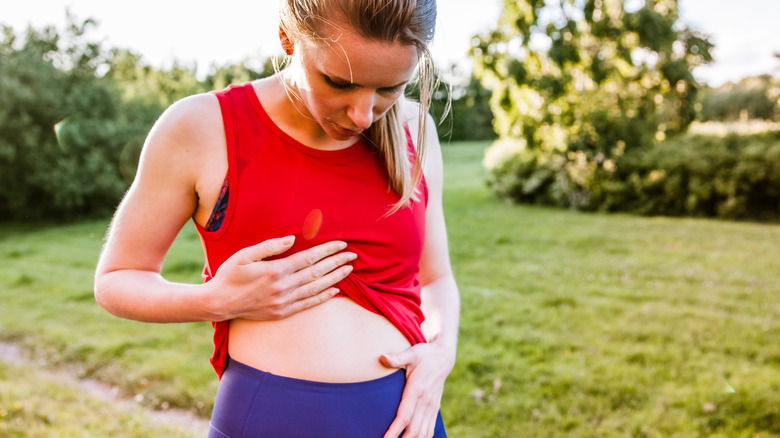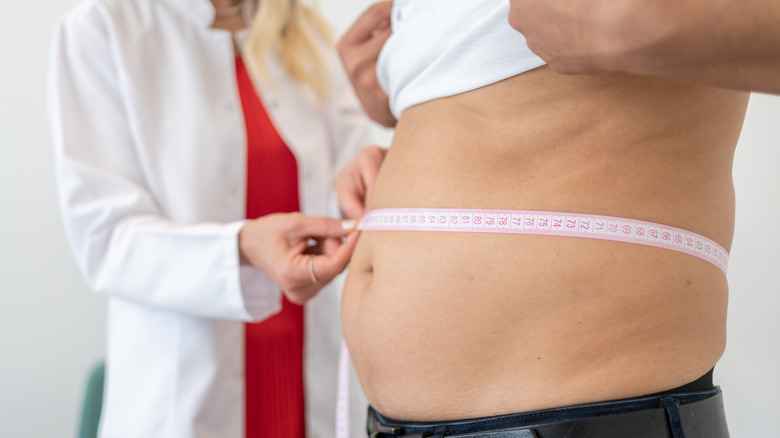The Unexpected Way Your Stomach Can Predict Your Risk Of Cancer
Maybe you don't spend too much time thinking about your risk of cancer until a family member develops cancer. Although a type of cancer isn't passed down through your family, you could inherit certain cancer-related genetic changes that could increase your risk of a specific type of cancer. Drinking alcohol, your diet, obesity, smoking, and exposure to ultraviolet radiation can all factor into your cancer risk.
Worldwide, the average risk of developing cancer throughout your life is 25%, but that risk is higher in developed regions such as North America, Europe, and Australia, according to a 2023 study in Science Bulletin. It might seem overwhelming to think about the many risk factors that can increase your risk of cancer, but you could take a look at your stomach to get an idea of your cancer risk. No, this doesn't mean asking a doctor to scope your stomach. Instead, take a look at how much belly fat you have. Although obesity increases your risk of cancer, a 2021 study in Nutrients says too much visceral fat can factor more heavily into whether cancerous tumors develop.
Waist-to-hip ratio over BMI
The World Health Organization classifies obesity as anyone with a body mass index (BMI) of 30 or above, and every 5-point increase in BMI increases your risk of cancers of the thyroid, kidney, colon, skin, gallbladder, and many others. A higher BMI also increases your risk of cancer mortality, particularly because obesity often comes with cardiovascular diseases and diabetes.
However, it might not necessarily be about BMI and more about white adipose tissue and visceral fat. White adipose tissue stores energy as fat and promotes inflammation and cancer development. Visceral fat is found around the organs (rather than subcutaneous fat that's more visible and near your skin's surface) and secretes more adipokines that could lead to inflammation and cancer. If you have more visceral fat, you have a 70% higher risk of developing pancreatic cancer than someone whose fat is in the hip region.
BMI doesn't distinguish between visceral and subcutaneous fat, and it also doesn't know how much lean muscle you might have. Instead, researchers can get a better estimate of visceral fat by measuring your waistline or waist-to-hip ratio. Regardless of BMI, some people might have an increased risk of cancer if their waist circumference or waist-to-hip ratio is higher. A 2023 study in JAMA Network Open found that your waist-to-hip ratio can better predict your risk of early death than BMI.
Healthy waist-to-hip ratio
Although Barbie's 16-inch waist gives her a waist-to-hip ratio of 0.56 (which might seem unrealistic), the World Health Organization says a healthy woman's waist-to-hip ratio is 0.85 or lower. Men should aim for 0.9 or lower. If your waist-to-hip ratio is higher than this, you might have more visceral fat, which can put you at risk for metabolic syndrome. You can also look at your waist circumference to assess your risk of metabolic complications. Men are at an increased risk if their waist circumference is more than 94 centimeters (37 inches) and a substantially increased risk if it's above 102 centimeters (40 inches). Women are at a higher risk of metabolic issues if their waist circumference is above 80 centimeters (31 inches) and substantially higher risk if it's more than 88 centimeters (34 inches).
No, that spandex waist trimmer or training your abs won't get rid of belly fat or spot-train your waist. Instead, exercising for at least 30 minutes a day combined with strength training can help burn off the unhealthy visceral fat and increase your muscle mass. Additionally, a healthy diet that's low in sugar and saturated fat can not only keep your visceral fat in check, but also reduce your risk of cancer.



